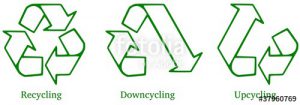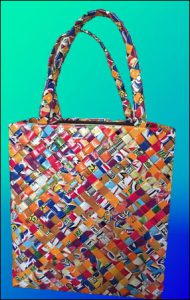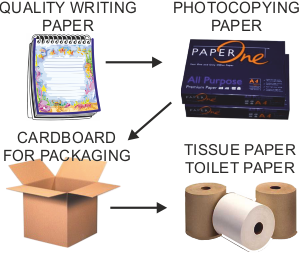Most recycling we do is open loop recycling. This means that a discarded product is not recycled back into the same product. Instead, a product’s materials — usually paper, metal, glass or plastic– are broken down so their  base materials can be used to make a new, different product. Usually this new product is of lesser quality because the recycling process degrades or weakens the material. This is called “downcycling” or reprocessing. But what if we could convert old or discarded products into something useful or beautiful? People are coming up with new ways to recycle products and actually increase their value. This is called “upcycling” or creative reuse.
base materials can be used to make a new, different product. Usually this new product is of lesser quality because the recycling process degrades or weakens the material. This is called “downcycling” or reprocessing. But what if we could convert old or discarded products into something useful or beautiful? People are coming up with new ways to recycle products and actually increase their value. This is called “upcycling” or creative reuse.
What is Upcycling?
Upcycling is not a new concept. It’s an old idea with a new label, coined in a 2002 in the book “Cradle to Cradle.” Upcycling (or creative reuse) gives a discarded item a new life with a better purpose and keeps it out of the garbage system for a longer period of time. When you upcycle, you don’t actually break down the materials, you just repurpose them. The new product is still made of the same material.
What’s old is new
People have always reused and repurposed everything out of necessity. Some people reuse and repurpose items because the  products have a beautiful or “artsy” aesthetic. Whatever the reason, upcycling should be a way of life for everyone. Upcycling doesn’t require any energy or water to break down materials so it’s a great way to help save the environment. It just takes creativity and patience.
products have a beautiful or “artsy” aesthetic. Whatever the reason, upcycling should be a way of life for everyone. Upcycling doesn’t require any energy or water to break down materials so it’s a great way to help save the environment. It just takes creativity and patience.
- tires turned into bowls
- magazines turned into a tote bag
- old doors turned into tables
- plastic bags turned into a backpack
Try to turn your milk, cartons, wine bottles, tires, jeans etc. into something useful or beautiful. if you can’t do it yourself, then support the upcycling movement by buying products from upcycled materials.
What is Downcycling?
Downcycling (or reprocessing) is the opposite of upcycling. With downcycling, a product is recycled into a product of degraded quality or lesser value. For example, steel from car scraps is contaminated with other metals such as  copper and can’t be recycled back into a cars. Instead, it is downcycled by remelting it into lower grade construction steel. Another example is paper. Paper can only be recycled into the same kind of paper or one of lesser value. Office paper can be recycled into office paper or magazines. Magazines can get turned into magazines or newsprint and so on down the line until the cellulose fibers get too short.
copper and can’t be recycled back into a cars. Instead, it is downcycled by remelting it into lower grade construction steel. Another example is paper. Paper can only be recycled into the same kind of paper or one of lesser value. Office paper can be recycled into office paper or magazines. Magazines can get turned into magazines or newsprint and so on down the line until the cellulose fibers get too short.
Do you know some fun or surprising products that are upcycled or downcycled? Share your comments, suggestions and questions below…